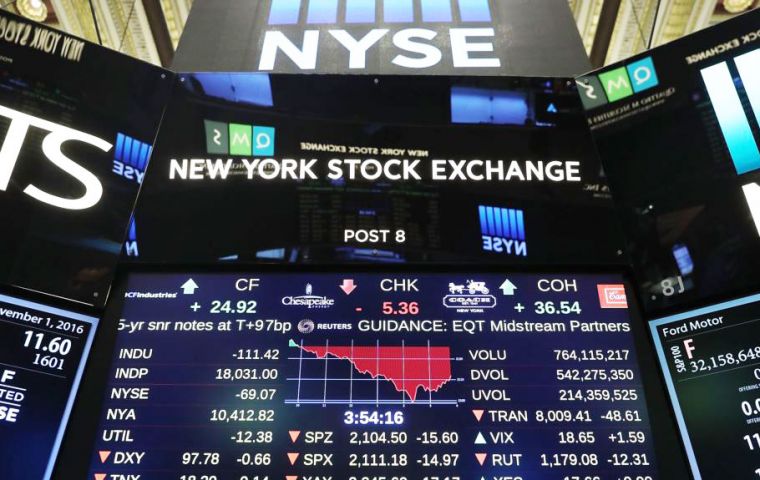MercoPress. South Atlantic News Agency
US stocks Monday plunge erasing 2018 gains; economy fundamentals are strong, says White House
 The declines for the benchmark S&P 500 index and the Dow Jones Industrial Average were the biggest single-day percentage drops since August 2011
The declines for the benchmark S&P 500 index and the Dow Jones Industrial Average were the biggest single-day percentage drops since August 2011 United States stocks plunged in highly volatile trading on Monday, with both the S&P 500 and Dow Industrials indices slumping more than 4%, as the Dow notched its biggest intraday decline in history with a nearly 1,600-point drop and Wall Street erased its gains for the year.
The declines for the benchmark S&P 500 index and the Dow Jones Industrial Average were the biggest single-day percentage drops since August 2011, a period of stock-market volatility marked by the downgrade of the United States’ credit rating and the euro zone debt crisis.
The question now for investors, who have ridden a nearly nine-year bull run, is whether this is the long-awaited pullback that paves the way for stocks to again keep rising after finding some value, or the start of a decline that leads to a bear market.
After regular trading hours on Monday, S&P 500 E-mini stock futures rose 0.73%, suggesting some traders expect Wall Street to open with a gain on Tuesday.
Bulls argue that strong U.S. corporate earnings, including a boost from the Trump administration’s tax cuts, will ultimately support market valuations. Bears, including short sellers that bet on the market decline, say that the market is over-stretched in the context of rising bond yields as central banks withdraw their easy money policies of recent years.
The U.S. stock market has climbed to record peaks since President Donald Trump’s election, on the prospect of tax cuts, corporate deregulation and infrastructure spending, and it remains up 23.8% since his victory. Trump has frequently taken credit for the rise of the stock market during his presidency, though the rally and economic recovery was well underway during the Obama administration.
As the stock market fell on Monday, the White House said the fundamentals of the U.S. economy are strong. U.S. economic growth was running at a 2.6% annualized rate in the fourth quarter last year and the unemployment rate is at a 17-year low of 4.1%.
On Monday, the financial, healthcare and industrial sectors fell the most, but declines were spread broadly as all major 11 S&P sectors dropped at least 1.7%. All 30 of the blue-chip Dow industrial components finished negative. With Monday’s declines, the S&P 500 erased its gains for 2018 and is now down 0.9% in 2018. The Dow is down 1.5% for the year.
The Dow Jones Industrial Average fell 1,175.21 points, or 4.6%, to 24,345.75, the S&P 500 lost 113.19 points, or 4.10%t, to 2,648.94 and the Nasdaq Composite dropped 273.42 points, or 3.78%, to 6,967.53.
On Monday, the S&P 500 ended 7.8% down from its record high on Jan. 26, with the Dow down 8.5% over that time. The declines come after the Dow and S&P posted their biggest weekly percentage drops since January 2016 last week, and the Nasdaq posted its biggest weekly drop since February 2016.
About 11.5 billion shares changed hands in U.S. exchanges on Monday, well above the 7.6 billion daily average over the last 20 sessions. Declining issues outnumbered advancing ones on the NYSE by a 8.64-to-1 ratio; on Nasdaq, a 6.92-to-1 ratio favored decliners. The S&P 500 posted 1 new 52-week highs and 38 new lows; the Nasdaq Composite recorded 17 new highs and 164 new lows.




Top Comments
Disclaimer & comment rulesCommenting for this story is now closed.
If you have a Facebook account, become a fan and comment on our Facebook Page!